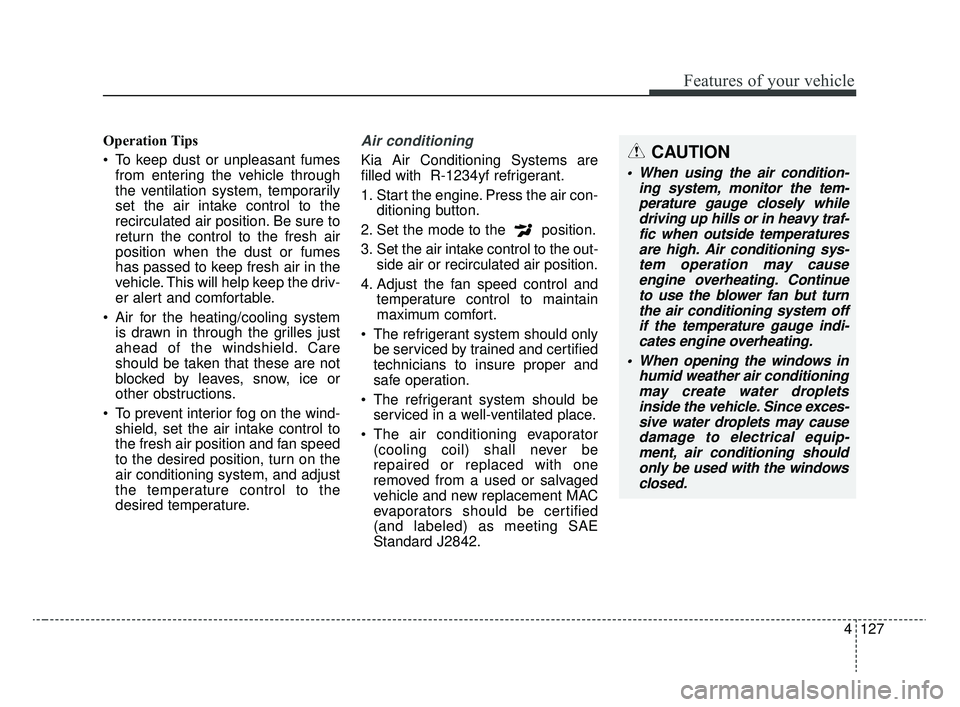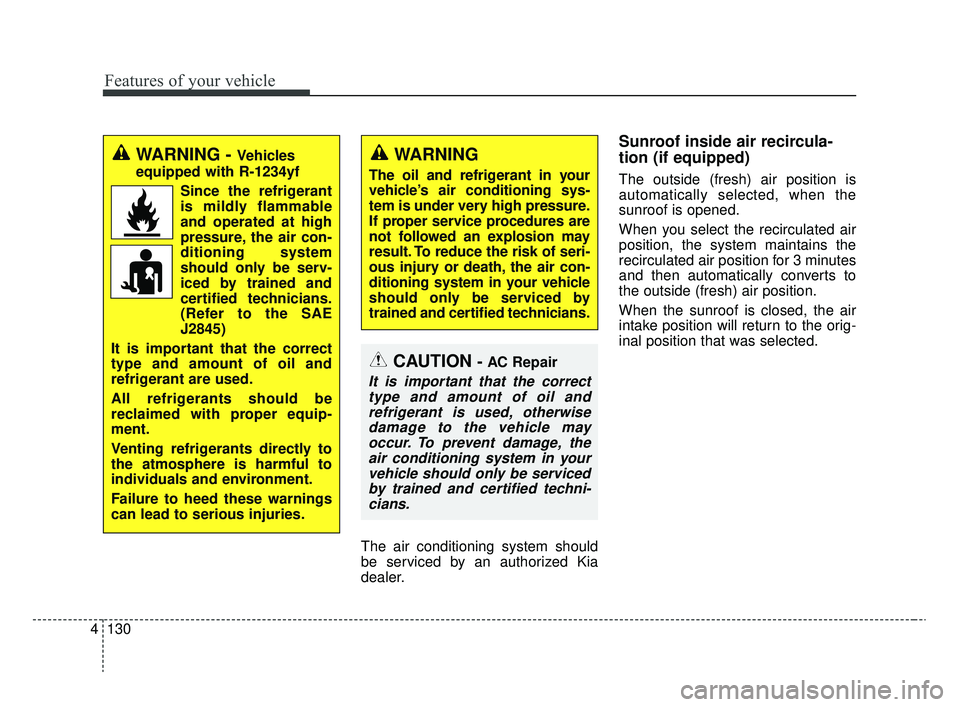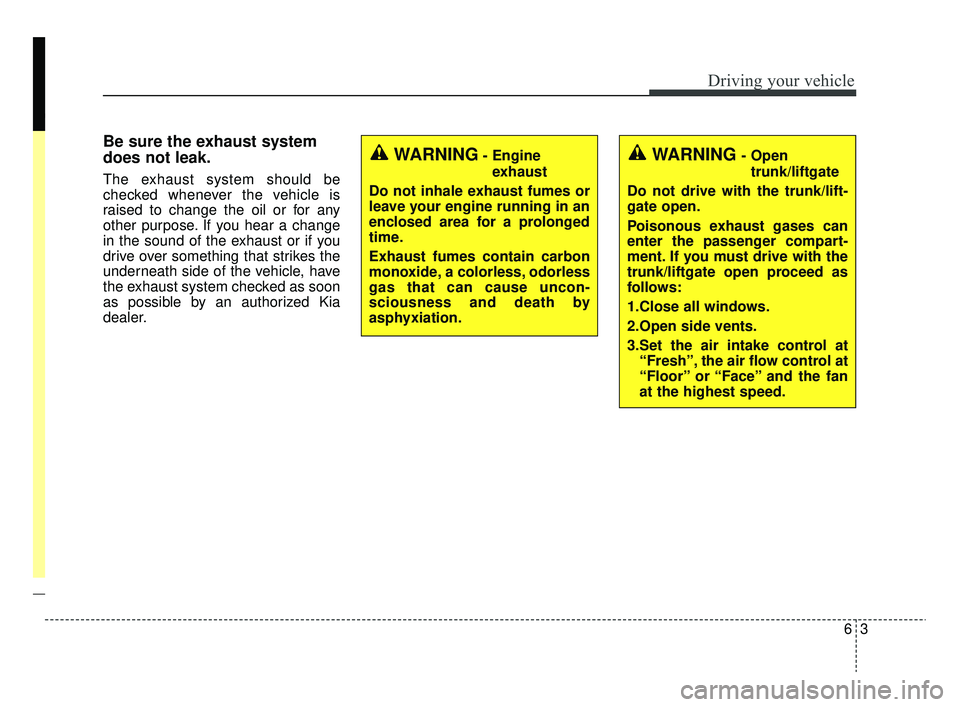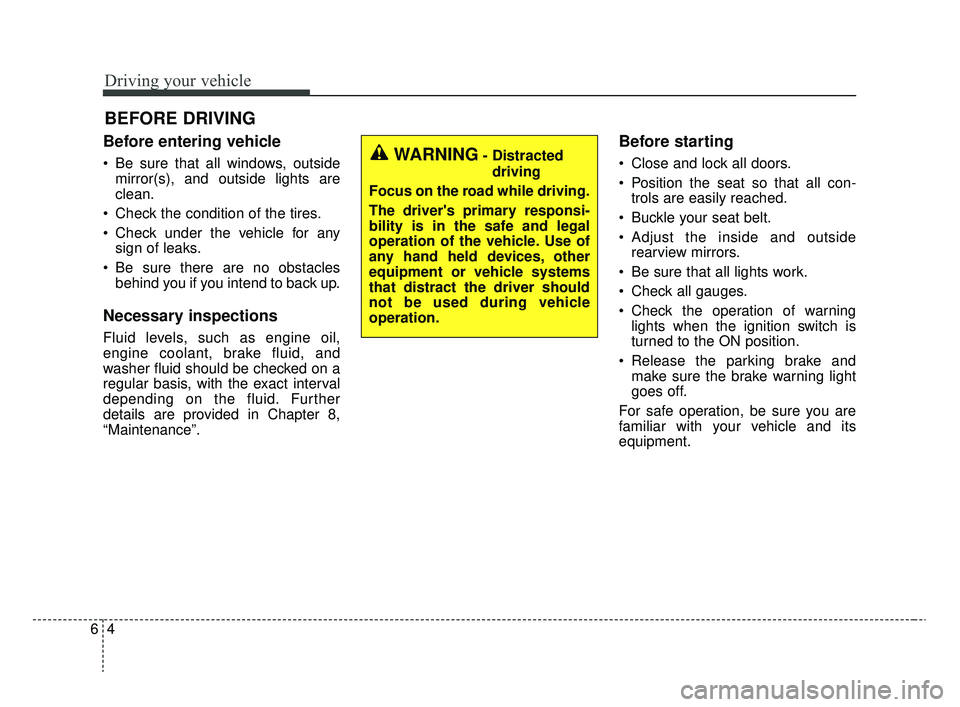Page 207 of 516

4127
Features of your vehicle
Operation Tips
To keep dust or unpleasant fumesfrom entering the vehicle through
the ventilation system, temporarily
set the air intake control to the
recirculated air position. Be sure to
return the control to the fresh air
position when the dust or fumes
has passed to keep fresh air in the
vehicle. This will help keep the driv-
er alert and comfortable.
Air for the heating/cooling system is drawn in through the grilles just
ahead of the windshield. Care
should be taken that these are not
blocked by leaves, snow, ice or
other obstructions.
To prevent interior fog on the wind- shield, set the air intake control to
the fresh air position and fan speed
to the desired position, turn on the
air conditioning system, and adjust
the temperature control to the
desired temperature.Air conditioning
Kia Air Conditioning Systems are
filled with R-1234yf refrigerant.
1. Start the engine. Press the air con- ditioning button.
2. Set the mode to the position.
3. Set the air intake control to the out- side air or recirculated air position.
4. Adjust the fan speed control and temperature control to maintain
maximum comfort.
The refrigerant system should only be serviced by trained and certified
technicians to insure proper and
safe operation.
The refrigerant system should be serviced in a well-ventilated place.
The air conditioning evaporator (cooling coil) shall never be
repaired or replaced with one
removed from a used or salvaged
vehicle and new replacement MAC
evaporators should be certified
(and labeled) as meeting SAE
Standard J2842.CAUTION
When using the air condition- ing system, monitor the tem-perature gauge closely whiledriving up hills or in heavy traf-fic when outside temperaturesare high. Air conditioning sys-tem operation may causeengine overheating. Continueto use the blower fan but turnthe air conditioning system offif the temperature gauge indi-cates engine overheating.
When opening the windows in humid weather air conditioningmay create water dropletsinside the vehicle. Since exces-sive water droplets may causedamage to electrical equip-ment, air conditioning shouldonly be used with the windowsclosed.
SC CAN (ENG) 4.QXP 12/12/2019 5:15 PM Page 127
Page 210 of 516

Features of your vehicle
130
4
The air conditioning system should
be serviced by an authorized Kia
dealer.
Sunroof inside air recircula-
tion (if equipped)
The outside (fresh) air position is
automatically selected, when the
sunroof is opened.
When you select the recirculated air
position, the system maintains the
recirculated air position for 3 minutes
and then automatically converts to
the outside (fresh) air position.
When the sunroof is closed, the air
intake position will return to the orig-
inal position that was selected.
WARNING
The oil and refrigerant in your
vehicle’s air conditioning sys-
tem is under very high pressure.
If proper service procedures are
not followed an explosion may
result. To reduce the risk of seri-
ous injury or death, the air con-
ditioning system in your vehicle
should only be serviced by
trained and certified technicians.
CAUTION- AC Repair
It is important that the correct
type and amount of oil andrefrigerant is used, otherwisedamage to the vehicle mayoccur. To prevent damage, theair conditioning system in yourvehicle should only be servicedby trained and certified techni-cians.
WARNING - Vehicles
equipped with R-1234yf
Since the refrigerantis mildly flammable
and operated at high
pressure, the air con-
ditioning system
should only be serv-
iced by trained and
certified technicians.
(Refer to the SAE
J2845)
It is important that the correct
type and amount of oil and
refrigerant are used.
All refrigerants should be
reclaimed with proper equip-
ment.
Venting refrigerants directly to
the atmosphere is harmful to
individuals and environment.
Failure to heed these warnings
can lead to serious injuries.
SC CAN (ENG) 4.QXP 12/12/2019 5:15 PM Page 130
Page 218 of 516
Features of your vehicle
138
4
CAUTION
To prevent damage to the goods
or the vehicle, care should betaken when carrying fragile orbulky objects in the luggagecompartment.
WARNING
To avoid bodily injury, DO NOT
overstretch the luggage net and
ALWAYS keep your face and
body out of the luggage net's
recoil path. DO NOT use when
the strap has visible signs of
wear or damage.
SC CAN (ENG) 4.QXP 12/12/2019 5:15 PM Page 138
Page 238 of 516
Audio system
13
5
CAUTION
When cleaning the device,
make sure to turn off the audiosystem and use a dry andsmooth cloth.
Do not place beverages close to the audio system. Spillingbeverages may lead to systemmalfunction.
Never use tough materials, chemical cloths, or solvents(alcohol, benzene, thinners,etc.) as such materials maydamage the device panel orcause color/quality deteriora-tion.
Prevent caustic solutions such as perfume and cosmetic oilfrom contacting the dashboardbecause they may cause dam-age or discoloration.
Refrain from use if the screen is blank or no sound can behear as these signs may indi-cate product malfunction.
Continued use in this conditionmay further damage the sys-tem.
CAUTION - LCD Monitor
Do not subject the device tosevere shock or impact. Directpressure onto the front side ofthe monitor may cause damageto the LCD or touch screen.
SC CAN (ENG) 5(audio).qxp 6/7/2019 9:52 AM Page 13
Page 269 of 516

6
Special driving conditions . . . . . . . . . . . . . . . . . . . 6-62
• Hazardous driving conditions . . . . . . . . . . . . . . . . . . 6-62
• Rocking the vehicle . . . . . . . . . . . . . . . . . . . . . . . . . . . 6-62
• Smooth cornering . . . . . . . . . . . . . . . . . . . . . . . . . . . . 6-63
• Driving at night . . . . . . . . . . . . . . . . . . . . . . . . . . . . . . 6-63
• Driving in the rain . . . . . . . . . . . . . . . . . . . . . . . . . . . . 6-64
• Driving in flooded areas . . . . . . . . . . . . . . . . . . . . . . . 6-65
• Driving off-road . . . . . . . . . . . . . . . . . . . . . . . . . . . . . . 6-65
• Highway driving . . . . . . . . . . . . . . . . . . . . . . . . . . . . . 6-65
Winter driving . . . . . . . . . . . . . . . . . . . . . . . . . . . . 6-67
• Snowy or Icy conditions . . . . . . . . . . . . . . . . . . . . . . . 6-67
• Use high quality ethylene glycol coolant . . . . . . . . . . 6-68
• Check battery and cables . . . . . . . . . . . . . . . . . . . . . . 6-68
• Change to "winter weight" oil if necessary . . . . . . . 6-68
• Check spark plugs and ignition system. . . . . . . . . . . 6-68
• To keep locks from freezing . . . . . . . . . . . . . . . . . . . . 6-68
• Use approved window washer anti-freeze in system . . . . . . . . . . . . . . . . . . . . . . . . . . . . . . . . . . . . \
. 6-68
• Don't let your parking brake freeze . . . . . . . . . . . . . 6-69
• Don't let ice and snow accumulate underneath . . . . 6-69
• Carry emergency equipment . . . . . . . . . . . . . . . . . . . 6-69
Vehicle load limit . . . . . . . . . . . . . . . . . . . . . . . . . . 6-70
• Tire and loading information label . . . . . . . . . . . . . . 6-70
• Certification label . . . . . . . . . . . . . . . . . . . . . . . . . . . . 6-73
Vehicle weight . . . . . . . . . . . . . . . . . . . . . . . . . . . . . 6-75
• Base curb weight . . . . . . . . . . . . . . . . . . . . . . . . . . . . . 6-75
• Vehicle curb weight . . . . . . . . . . . . . . . . . . . . . . . . . . . 6-75
• Cargo weight . . . . . . . . . . . . . . . . . . . . . . . . . . . . . . . . 6-75
• GAW (Gross Axle Weight) . . . . . . . . . . . . . . . . . . . . . 6-75
• GAWR (Gross Axle Weight Rating) . . . . . . . . . . . . . 6-75
• GVW (Gross Vehicle Weight) . . . . . . . . . . . . . . . . . . . 6-75
• GVWR (Gross Vehicle Weight Rating) . . . . . . . . . . . 6-75
SC CAN (ENG) 6.QXP 6/7/2019 9:49 AM Page 2
Page 270 of 516

63
Driving your vehicle
Be sure the exhaust system
does not leak.
The exhaust system should be
checked whenever the vehicle is
raised to change the oil or for any
other purpose. If you hear a change
in the sound of the exhaust or if you
drive over something that strikes the
underneath side of the vehicle, have
the exhaust system checked as soon
as possible by an authorized Kia
dealer.
WARNING- Engineexhaust
Do not inhale exhaust fumes or
leave your engine running in an
enclosed area for a prolonged
time.
Exhaust fumes contain carbon
monoxide, a colorless, odorless
gas that can cause uncon-
sciousness and death by
asphyxiation.WARNING- Open trunk/liftgate
Do not drive with the trunk/lift-
gate open.
Poisonous exhaust gases can
enter the passenger compart-
ment. If you must drive with the
trunk/liftgate open proceed as
follows:
1.Close all windows.
2.Open side vents.
3.Set the air intake control at “Fresh”, the air flow control at
“Floor” or “Face” and the fan
at the highest speed.
SC CAN (ENG) 6.QXP 6/7/2019 9:49 AM Page 3
Page 271 of 516

Driving your vehicle
46
Before entering vehicle
• Be sure that all windows, outsidemirror(s), and outside lights are
clean.
Check the condition of the tires.
Check under the vehicle for any sign of leaks.
Be sure there are no obstacles behind you if you intend to back up.
Necessary inspections
Fluid levels, such as engine oil,
engine coolant, brake fluid, and
washer fluid should be checked on a
regular basis, with the exact interval
depending on the fluid. Further
details are provided in Chapter 8,
“Maintenance”.
Before starting
Close and lock all doors.
Position the seat so that all con-trols are easily reached.
Buckle your seat belt.
Adjust the inside and outside rearview mirrors.
Be sure that all lights work.
Check all gauges.
Check the operation of warning lights when the ignition switch is
turned to the ON position.
Release the parking brake and make sure the brake warning light
goes off.
For safe operation, be sure you are
familiar with your vehicle and its
equipment.
BEFORE DRIVING
WARNING- Distracted driving
Focus on the road while driving.
The driver's primary responsi-
bility is in the safe and legal
operation of the vehicle. Use of
any hand held devices, other
equipment or vehicle systems
that distract the driver should
not be used during vehicle
operation.
SC CAN (ENG) 6.QXP 6/7/2019 9:49 AM Page 4
Page 333 of 516
Driving your vehicle
66
6
Fuel, engine coolant and engine
oil
High speed travel consumes more
fuel than urban motoring. Do not for-
get to check both the engine coolant
and engine oil.
Drive belt
A loose or damaged drive belt may
overheat the engine.
SC CAN (ENG) 6.QXP 6/7/2019 9:51 AM Page 66